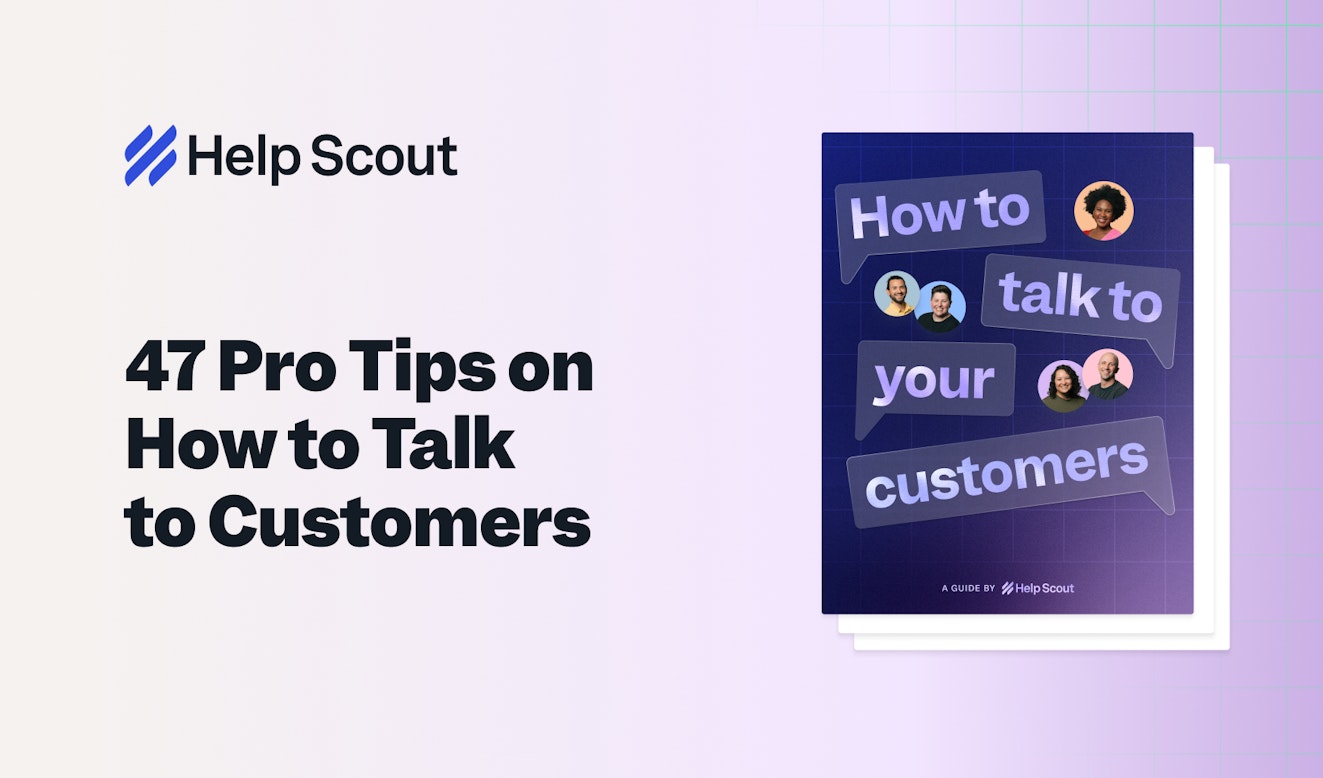Great communication is both an art and a science.
There are certainly guidelines you can stick to to communicate well, but in the end, making a human connection is what really makes communication powerful.
When you’re thoughtful about the way you convey information to (and receive feedback from) customers, it will yield better results than any splashy new logo or 20 percent off coupon ever could.
But what does “thoughtful” communication mean when you’re talking to a customer? What’s the strategy behind successful conversations?
World-class customer service begins with treating humans like humans. Follow the tips on how to talk to customers in this guide, and we guarantee you’ll be on your way to delighting your customers.
Maintaining a consistent tone
In music, if the singer’s tone is off, the whole piece falls flat, and it’s the same in customer service. For example, “Anything else?” and “What else can I help you with?” ask the same question, but they are wildly different in terms of tone.
As you define your support team’s collective voice, develop a set of standards for personal and human conversations. This allows each member to maintain their unique voice without sounding like they’re talking from a script.
1. Think of tone on a spectrum
Take the examples above: “Anything else?” and “What else can I help you with?”
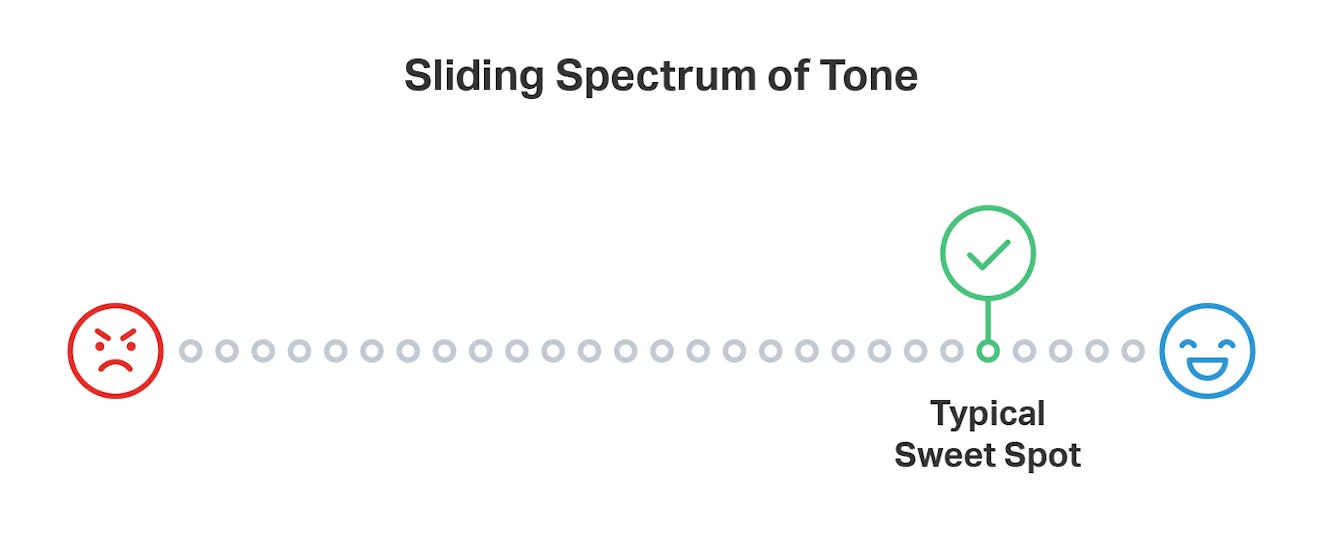
One is clearly sliding into bitter-sounding territory while the other feels friendly but still professional. That’s where you’ll want to be for the large majority of customer interactions.
For example
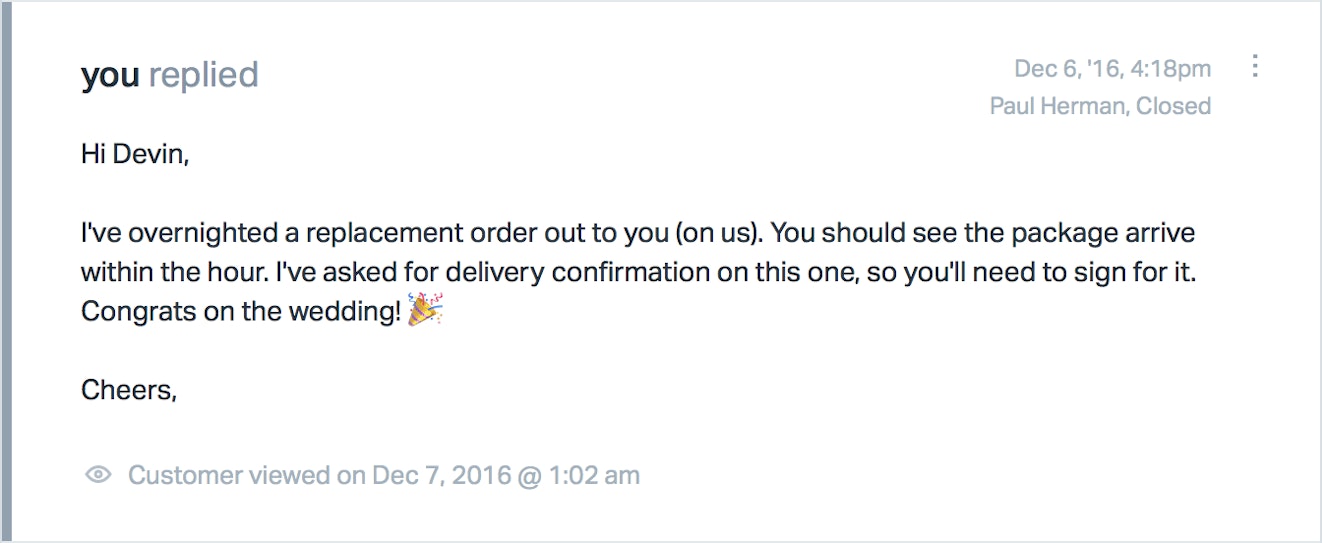
2. Use positive language
Positive language keeps the conversation moving forward and prevents accidental conflicts due to miscommunication. Words like can’t, won’t, and didn’t — and phrases like “you have to” or “you need to” — are usually interpreted as negative.
Focus on how you’re going to fix the problem and avoid words that cause knee-jerk reactions.
For example
Negative: “No, we don’t have that.”
Neutral: “I can see how that would be useful, but I’m afraid we don’t have plans to add that functionality.”
Positive: “While there’s currently no way to do that, we appreciate you taking the time to let us know what you’re looking for — most of the improvements we make come from ideas and suggestions like yours, so thank you for reaching out!”
Say one of your products is backordered for a month and you need to relay this information to a customer immediately. Consider the following responses.
With negative language:
“I can’t get you that product until next month; it’s backordered and unavailable at this time. You’ll have to wait a few weeks, but I’m happy to place the order for you right now!”
With positive language:
“It looks like that product will be restocked and available next month. I can place the order for you right now and we’ll make sure it’s sent to you as soon as it reaches our warehouse!”
Redirecting the conversation from negative to positive places focus on the proposed solution. When the outcome takes center stage, it reduces the odds that customers will be upset.
Customers don’t care about what you can’t do; they want to hear what’s going to be done.
For those tricky situations where customers “have to” do something, you can use positive language to remind them (and yourself) that this is a team effort.
With negative language:
First, you'll have to check...
Now, you'll need to set up...
After that, I need you to...
With positive language:
First, let's verify...
Now, we can set up...
After that, the best solution is if we...
Positive language keeps the door open for future interactions, and the customer won’t feel as though it was a waste of time to get in touch.
3. Be brief but not brusque
It doesn’t matter how amazing your reply is — most customers are going to ignore a 1,000-word email.
Keep sentences and paragraphs short; large blocks of text will get skipped right over. You can also use images, videos, and links to knowledge base articles to keep your replies concise.
Bonus: When your knowledge base is integrated with your help desk, the process is easy because you can pull in articles without exiting your reply!
The goals of a support reply are to answer the customer’s question and to make them feel heard. You might be able to answer a question with a link to an article in your knowledge base, but adding a sentence or two is more human.
Learn more about Help Scout:
4. Reply in a timely manner
When you can modify your saved reply with the customer’s name and an acknowledgment of their specific issue within 30 seconds, it can make some people wonder if their email even got read. It’s OK to let non-urgent emails sit a few extra minutes.
Of course, customers who are in a “pulling my hair out” situation want a resolution yesterday. Make responding to them a priority.
Try setting up a folder separate from the main support queue where you can filter urgent or upset messages. Here, the team can see immediately which emails are from customers who need help right away.
5. Always use your customer’s name
If you’re not using the customer’s name in your greeting, you’re missing an opportunity to use the psychology of consumer behavior to your advantage. Dale Carnegie advised readers to “Remember that a person’s name is to that person the sweetest and most important sound in any language.”
Your help desk should allow you to automate using the customer’s name.
Just be sure to get it right — use the name they use. Sérgio is Sérgio, not Sergio. Katie is Katie, not Kate. If you don’t have the person’s name, go with a friendly, generic greeting: “Hey there!”
6. Talk their talk
Mirroring your customer’s tone lets them know you’re on their side. If a customer is formal, for example, hold back on using internet shorthands like “lol” or “lmk.” If they’re more casual, you can relax your tone, too.
For a majority of interactions, the sweet spot is almost always “somewhat like your customer” but not a caricature of your customer.
One scenario where mirroring is not a good approach is when a customer is clearly angry. In this case, the goal is to de-escalate the situation. Keep your tone calm and your words free of defensive language.
7. Be careful with jokes
Gauge your rapport with the customer before attempting any jokes, sarcasm, or irony — they don’t translate easily through text, so your intent can easily be misunderstood.
While emojis and GIFs certainly help, there’s still no sarcasm font, so choose every word with thoughtfulness and care.
8. Create a support style guide
A style guide documents all the unique elements that make up your brand so everyone on your team can provide a consistent experience across the board. It should provide guidelines but not stifle creativity. Focus on the dos and don’ts of tone and language, and outline the sort of customer service you admire.
For instance, the style guide Help Scout’s support team uses covers everything from what to call emails from customers (“conversations,” not “tickets”) to words to avoid (“inconvenience,” “unfortunately”) to how to format telephone numbers.
Creating a distinct language or using specific phrases reflects and instills the values of the company across every team member, reminding them of what they represent and the standards by which they must abide.
Pro Tip: Develop your own vocabulary
Consider creating a “support lexicon” of phrases for your team to live by, such as “my pleasure” and “right away.” A support lexicon is like wearing your team’s colors. It signals, “This is who we are; this is how we do things.” When those values and beliefs are fostered at the start, it helps employees form an identity around these beliefs and behaviors, and remarkable service ensues.
9. Build templates for saved replies
A living database of saved replies that your team can actively build on saves time by streamlining how you answer common questions.
A new customer who needs to know how to reset her password still deserves help, but this is a conversation that warrants a template. You’ll gain more time to have high-value conversations, which result in real insights.
Establishing a relaxed set of guidelines encourages the team to use their guts to decide when a new saved reply needs to be added; “I feel like we get this question a lot” is often all the justification you need.
Pro Tip: Don't hold back on saved replies
Be liberal with adding new saved replies. There is little downside to having a large library of replies other than getting somewhat trigger-happy and ending up with replies you rarely use. However, it’s easy to access them via your shared inbox's search feature, so this won’t generally be a problem.
Want some tips on how to use saved replies? Check out these tips from the Help Scout support team.
10. Give directions chronologically
If you can do something for a customer, by all means, do it. The lower their perceived effort, the better they’ll rate your customer service.
When you really do need a customer to carry out a lengthy set of instructions on their own, use numbers or bullet points. Say, for instance, you need the customer to perform a traceroute to help you troubleshoot why a certain page is loading slowly, and you’ve already exhausted the other possibilities. You can advise something like the following:
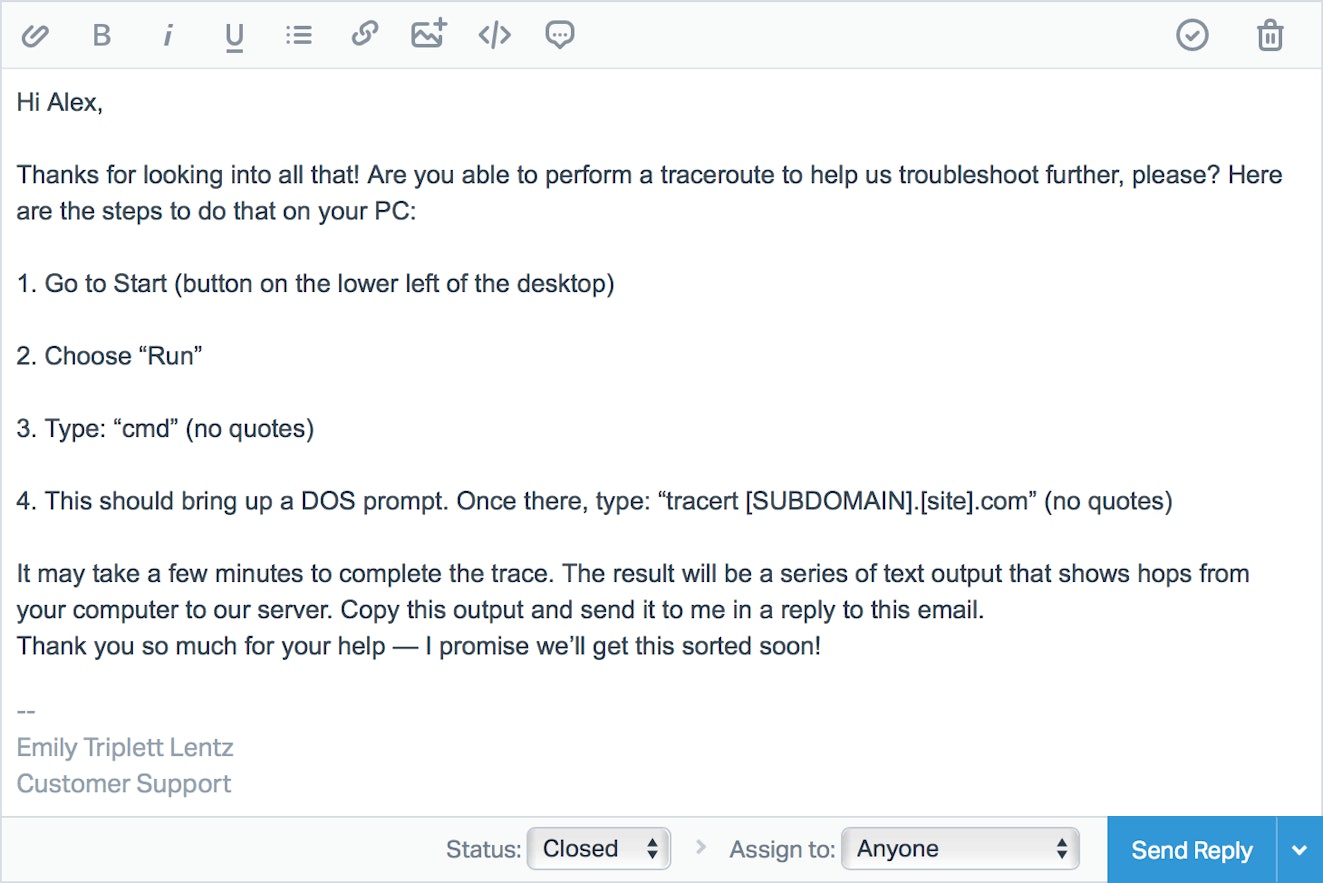
11. Cross-check whole-company support replies
Whole-company support is fantastic for a number of reasons, but don’t let people who aren’t trained in the art of support fire off replies without the sign-off of a seasoned pro.
Have non-support folks use your help desk’s @mentions feature in an internal note to a support team member so they can quickly review your draft reply before shipping it. Remember, customer support is challenging, specialized work — not just anyone can do it.
12. Offer to help further
Avoid ending conversations so bluntly that the customer feels you are hurrying them out the door. Instead, invite them to continue the conversation.
“Let me know if there’s anything else I can do for you. I’m happy to help.”
Make sure your customer knows you’re happy to assist with any lingering concerns or answer questions they may feel are “silly.” There are no silly questions in support.
13. Show, don’t just tell
When possible, take a quick screen recording to show customers what to do versus typing it out in steps. This tip comes from Denise Twum, Customer Support at SmugMug:
Instead of telling customers what to do, show them! I use Recordit for screencasts — it’s free and generates a link, instead of having to attach a bulky file to your responses.
Now when someone writes in asking how to find a particular page in their account, I can log into the account and record the steps, versus typing out “1. Go here, 2. Click here, 3. Click this green button.”
It’s fast and doesn’t need to be super polished since it’s not for your knowledge base or a blog post. It saves a lot of back-and-forth and has made all the difference!
14. Clarity, clarity, clarity
Use accessible, candid, precise, plain language. Avoid using passive-aggressive or didactic language (“actually,” “ought to,” “should”), slang, colloquialisms, and technical jargon. For a refresher on clarity, we recommend “The Elements of Style” or these writing guides.
15. Steer clear of customer service clichés
Which one of the following statements is more engaging?
“You are being transferred. Your call is very important to us.”
“Hi Angela, I’m going to introduce you to Tim, our customer success specialist who will be better able to answer your question!”
Easy. One is a trite platitude that people are sick of hearing, while the other explains to customers why the transfer is to their benefit. The wording makes all the difference.
16. Talk to your customers like people
... because they are. Consider the following disappointing example:
Hi,
We just received your inquiry. We’ll get back to you about your order as soon as possible. For your records, your support ticket number is #1234567. Include it in any future correspondence you might send.
— The App Team
The customer is literally treated like a number. The overly formal tone doesn’t engage the customer at all — is this an “inquiry” or a conversation with a real person?
Be friendly, personable, and casual. A follow-up email like this works better:
Hi there!
Thanks for your order with us! This is an automatic email just to let you know I’ve received your email. I’ll get you an answer shortly.
Thanks!
Rick Smithson, Customer Support
Customers want to be treated with respect. The day you stop talking to them like regular people is the day you lose touch and relevance. After that, you start losing customers.
17. Simplify for foreign-language customers
When a customer contacts you in another language, use a translation tool, and write for translation by using active voice and simple words. Skip the idioms. Lean on visuals more heavily than text. If anyone on your team speaks the customer’s language, ask them to check your reply!
Pro tip: Use AI to help with translations
Many customer support tools are starting to incorporate AI features capable of translating a response from within the conversation editor.
Help Scout’s AI assist can translate replies into Chinese (Simplified), Dutch, English, Filipino, French, Korean, German, Indonesian, Italian, Japanese, Portuguese, Russian, Spanish, and Vietnamese.
In addition, it can help with other things like correcting spelling and grammar mistakes and adjusting the length and tone of a response.
While you should always default to having a native speaker respond to a foreign-language request if possible, tools like AI assist make it a little easier to communicate with customers in the moment without additional software.
18. End on a high note
Make sure you always get to a place where, “Yes, I’m all set!” rings loud and clear. Try ending your conversation with a phrase like this:
“Excellent! I’m glad we were able to get that sorted out for you. Before you go, is there anything else I can assist you with today? I’m happy to help.”
Believe it or not, some customers might not mention that they have another problem if you don’t ask them about it. Adding “I’m happy to help” shows the customer that answering another question isn’t a burden; in fact, you’d be happy to do it.
Mastering difficult conversations
Feature requests that aren’t on the roadmap, items you don’t have in stock, rules that can’t be bent — you can’t always say yes, but there are ways to mitigate the pain for your customers.
Whether you end up with a satisfied customer or an unhappy one might come down to how you phrase your response.
Difficult support situations aren’t easy (or fun) to handle, and there’s rarely a “perfect” solution to any problem. But with a little preparation, you can approach challenges with tact and grace, allowing you to keep standards high and make better decisions no matter what comes your way.
These techniques will help strengthen your personal relationships with customers as well as your reputation as a company that cares.
19. Apologize sincerely
As the ambassador of your company, you accept responsibility for the customer’s unhappiness. This doesn’t make you “at fault,” nor does it give the customer leeway to demand whatever they want. But it does give them someone to talk to instead of being angry at a faceless company.
“I’m sorry” is mandatory even in situations that aren’t your fault. Consider your “I’m truly sorry about that” a personal apology to the customer that the experience wasn’t up to their expectations — not that you are to blame.
20. But don’t linger on the apology
Focus your reply on action. Acknowledge the problem the customer is reporting, but spend most of your time focusing on what you’re going to do about it.
Say you’re sorry when it’s genuine, empathize, then move on to solving the problem or giving them context to their issue.
21. Be direct
When a customer reports a bug, they’re likely pretty frustrated. In both the initial report and in your follow-up, cut to the chase and don’t waste their time.
Overtures, no matter how well intentioned, just delay the message, so keep your communication focused before adding any warm fuzzies.
22. Admit when you’re in the wrong
Whoops! Say a bug deletes some of a user’s settings or your site is under a DDoS attack. Excessive technical details won’t placate many customers or make the inability to use your product or access your site any less annoying. Instead, do the following:
Apologize outright.
Explain the game plan.
Let them know how you’ll be in touch.
Follow up when it’s fixed.
In 2016, Help Scout faced some uncharacteristic downtime. It was a terrible feeling, but we knew we couldn’t just stick our heads in the sand and hope people wouldn’t notice. We sent our customers the following email:

Nearly all the replies we received were along the lines of, “That’s okay, folks; we know how it goes sometimes! Keep up the great work!” Own up to your mistakes, follow up promptly, and take steps to ensure it doesn’t happen again. You’ll find your customers are a forgiving bunch.
23. Get personal
Great support is defined by genuine compassion. Use “I” messaging to demonstrate yours: “I completely understand why you’d want that,” or “I know how {blank} that can be.”
What you use in that {blank} will greatly affect the tone of your message — one that is obviously being used with an upset customer. Read the customer’s mood and relate with how they feel.
24. Admit what you don’t know
Don’t beat yourself up for not knowing an answer. A support rep’s responsibility is to have the tenacity to make things right, not to be perfect (especially true if you’re new).
Being speedy is never as important as communicating with accuracy. If you need time to dig into an issue, simply state that you’re going to find out the exact answer they need, and do just that.
The important thing is that you communicate. If your average response time is 30 minutes, don’t leave a customer hanging for hours just because you don’t know how to answer their question. Reply to let them know you’re looking into it and you’ll be in touch as soon as you know more.
Should you need to assign the conversation to another team, they may realize the issue could take a while. Have processes in place for situations like these. Allow other teams to reply to the customer directly to tell them they’re working on it, or flip the conversation back to support so the customer isn’t left hanging.
25. Ask for their “why”
When customers are vague about why they’re upset, they’re handing you the opportunity to request specifics.
Customer: Your update looks terrible. Make it more like it was before!"
Customer Support: “Oh no, sorry to hear that! Would you mind telling me a little more about what you liked better about the old version?”
You may do something with that intel and you may not, but it’s a win either way: They hopefully walk away pleased that someone is listening and flattered that someone cares enough to want their opinion.
People will complain about your product no matter how well it’s built, so just make sure your language is level-headed and professional.
26. Thank them for the heads up
People who offer detailed information about a bug they encountered are the unsung heroes of your product’s quality control.
Most customers don’t speak up, so you should cherish those who do.
Show them your gratitude by replying with a “Thanks so much for the heads up!” or preferably, “Hey, I really appreciate you taking the time to bring this to our attention!”
If they went above and beyond to help you fix something, send a handwritten thank-you note or perhaps even a gift.
27. Let customers know they can hold you personally accountable
This tip comes from technical support pro Matt Hunter:
When you need to forward a conversation to another department, include the phrase ‘Let me know if they don’t get back to you’ in your reply to the customer. It shows them you’re their ally in case someone else drops the ball.
Once I started making sure the customer knew it was okay to hold me accountable, it ended any bad feedback when the other department forgot to follow up. Customers feel like they can contact support and get instant results, which is great.
When the customer does reply to tell me they haven’t gotten a response, I always thank them for the follow up, so they know it’s mutually beneficial. Making the customer feel like they are part of the troubleshooting process and solution is huge.
28. Feel free to “sandwich” bad news
When you can’t give a customer what they want, try to sandwich the bad news between two hopeful pieces of bread:
“That’s a great idea. I’m sorry we can’t do that right now because (XYZ), but we’ll absolutely keep you posted if anything changes. Thanks again for reaching out!”
“Good catch on that bug; you have an eagle eye. It might be a while before we can get that one fixed. We’re keeping an eye on other reports and will let you know if we have news!”
Never stop at no. Instead, offer a workaround, explain the reasoning behind why you’re not working on a certain issue, or suggest another product or service that might be a better fit.
29. Take a breather
When you feel a strong negative emotion, make sure to double and even triple check what you’ve written to a customer before you send it. No matter how their message made you feel, it’s your job to keep the conversation productive, so go back and read what you’ve written to make sure your emotions didn’t end up in your reply.
Use your team for gut checks — ping a teammate in a note and ask them to review your draft reply to see if they catch anything you might have missed or have suggestions for framing your message more positively.
30. Let the customer know you’re their advocate
Showing customers how you’re advocating for their needs can lead to a reduction in their perceived effort.
Clearly align yourself with them in favor of getting their problem solved without deferring blame or muddying the situation by over-explaining what you can’t do. Instead, reiterate your commitment to solving the problem by describing the following:
What you’ve just done.
What you will do.
How your actions are in support of their desired outcome.
Why you genuinely sympathize with any frustrations they may have faced.
“I can’t replicate your issue” is a good example here. It may be true, but without context, this reply feels flippant and lazy. You can accidentally leave the customer with the impression that you’d rather blame them instead of investigating the problem.
Quickly explaining the paths you already explored shows your thought process so the customer knows what you’ve tried and can see what lead you to suggest the solution.
31. Focus on the end, not the means
The best solution you can provide isn’t always a solution the customer asked for. Getting to the bottom of what a customer is trying to accomplish can help you solve the problem in a way they haven’t considered.
With a little back-and-forth, you might discover that the customer asking for sub-projects really just needs a way to organize different teams sharing the same account, and hey, your product can do that!
Once you know what their real goal is, suggest that it may take a bit of an adjustment to their current workflow, but there’s still a way to do what they’re ultimately trying to do
Customers care more about the end than the means. If you’re aware of the customer’s desired outcome and speak to that, your alternative might not look so bad after all.
32. Explain what’s going to happen next
When customers make requests you’re unable to fulfill right away, you can still give them something — often, just knowing someone is listening is enough.
“I’m sorry there’s no way to do that at this time. However, we have had other customers request this feature and the team is considering it for a future release. I’m going to add your vote to the feature request and if anything changes, I’ll reach out to you with an update.”
As a customer, it’s comforting to be assured your request won’t disappear into the ether — there’s a process for handling requests, and you’re being taken seriously.
33. Honesty is always the best policy
It’s better to say no and potentially disappoint a customer than hedge with falsehoods such as “Hmm, good idea, let me check with the product team and get back to you.” If the answer is really no, it’s best to be upfront about that.
People can generally spot insincerity when they see it, so if you don’t think it’s a good idea to add yet another checkbox on the settings page, don’t make them think you do.
34. Make your customers feel heard
The next best thing to giving customers what they want is showing them you take their ideas seriously.
Often, people just want to know you’re listening. Small touches like using the customer’s name and phrases like “I understand” or “I can see why you’d want that feature” go a long way.
Thank customers for telling you what they’re looking for. Whatever their issue, it was important enough to take time out of their day to contact you. Acknowledge the effort and your gratitude for it.
Angry customers are often just as interested (if not more interested) in hearing that someone empathizes with their situation over getting the actual problem fixed. When you have to refuse a request, show your empathy and willingness to find an alternative solution. It is one of the best ways to lessen the sting of saying no.
35. Offer alternatives
You want to create happy customers, not marginally satisfied ones. When you don’t have what they’re looking for, you still have the opportunity to generate goodwill by pointing them toward a workaround or even a competitor.
Zappos, for example, refers customers elsewhere when they don’t have an item in stock — CEO Tony Hsieh has said that while they may lose the sale, in the long run it’s best for Zappos because “the customer appreciates the help and tells their friends the story.”
The resulting long-term loyalty and word-of-mouth advertising outweigh any short-term loss.
36. Explain the reasoning behind the issue
When people understand the “why,” they’re more likely to be forgiving. Say, for example, a customer wants your company to bring back a feature that was available in previous versions of your software. Don’t just tell them no; explain why.
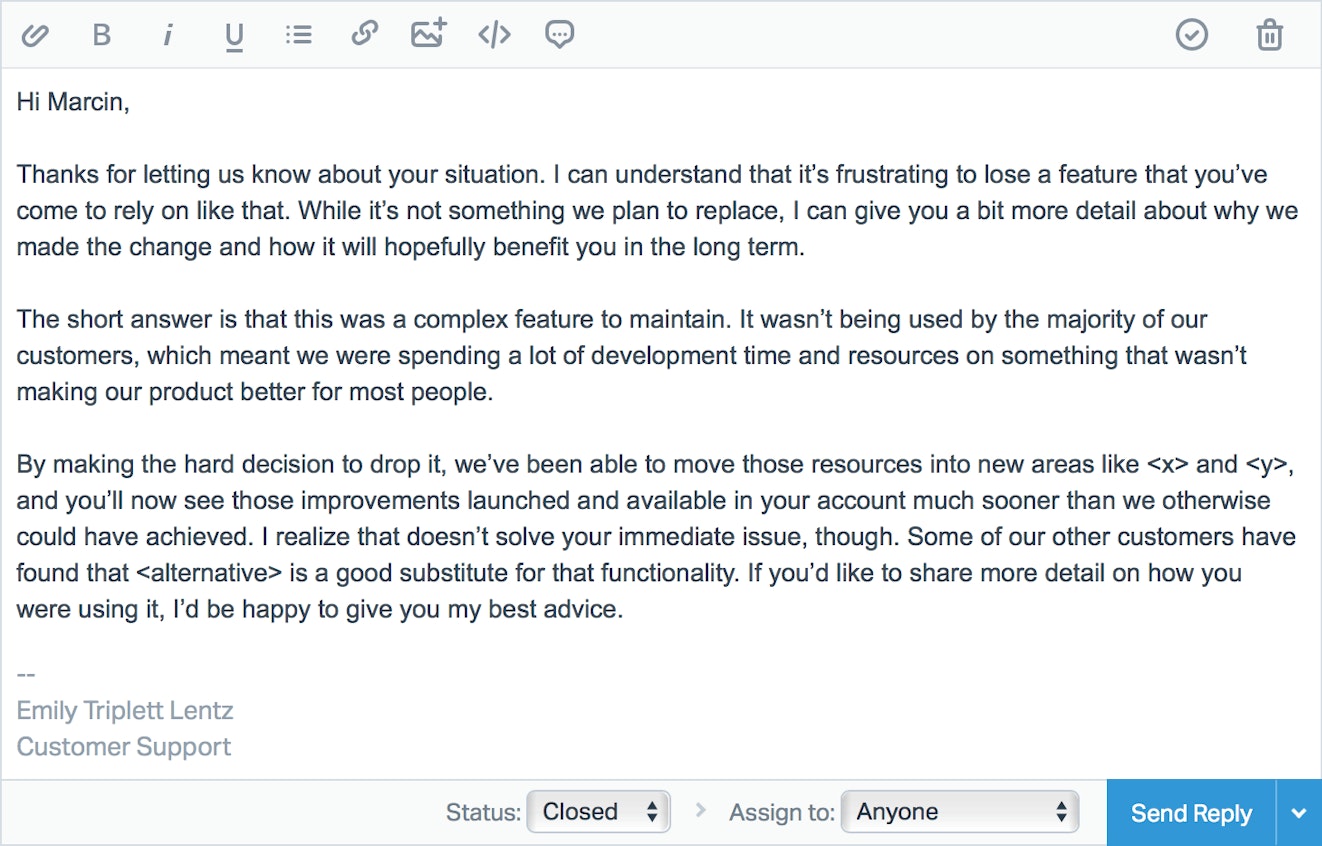
It may not be the answer the customer wanted to hear, but an honest explanation and workaround is often enough to satisfy them when they didn’t get what they originally asked for.
37. Resist the temptation to mirror negativity
Here’s where “mirroring” doesn’t apply. Even when the customer is being unreasonable, apologize outright and ask how you might help resolve the issue..
“We’re sorry that you are having this problem” is an infuriating phrase for a customer to hear. It is nothing more than the deferment of blame. The attempt to apologize comes off as dismissive, all thanks to a misuse of tone.
If you come across a lost cause, keep it friendly, keep it professional, and keep it moving.
38. Transfer quickly, but explain why
Handing people off should be handled with care — never miss an opportunity to briefly explain to a customer why this movement will be to their benefit. It’s nearly impossible to get anyone excited about being transferred, but consider the two choices you have:
“I’ll have to transfer you for that.”
“I’m going to set you up with our specialist, Laura, who will get that squared away for you right away.”
Without this brief but relevant insertion, customers won’t know that you are actually doing the best thing, and second only to doing the best thing is letting people know you are.
39. Don’t drag out a lost cause
If a customer wants to cancel their account, do it right away. Nothing makes for a bitter departure quite like running your customers through the gauntlet when all they want to do is leave.
Winning customers back with exceptional service is fundamental, but when they already have one foot out the door, you’re better off reducing friction as they part. Learn what you can, see if there is a way to resolve the issue, and accept the outcome if there isn’t.
Customers aren’t necessarily gone for good just because they cancel their account. Hassling upon exit, however, will ensure they never return.
40. Remain firm when security is at stake
Support professionals’ natural inclination to help can leave team members open to social engineering if they aren’t careful. If your product has different permissions that deal with security or payment responsibilities, for example, you’ll have customers ask you to switch their roles, such as transferring account ownership.
You’ll want to assist right away, but you’ll need approval from the current account owner.
Email that person (separately, so the reply can’t be spoofed), and let the person making the request know you’ve done so and that it’s all about keeping their account safe. When the owner responds, check to make sure the original message you sent is included in the reply. No detail is too small when it comes to security.
You may still run into something like, “But the account owner is on vacation/has been fired/is very busy and important!” There’s always something, isn’t there?
For these situations, it helps to have a policy you can point to on your website. That way, they know you’re not being obstinate; rather, you’re serious about security and unable to make exceptions. That isn’t always easy for people to stomach, but you’ve still got to do the right thing.
41. Don’t pass the buck
If you’ve messed up, pass the conversation on (with context) to your supervisor to figure it out together from there. Mistakes happen, and it’s best to own up right away when you’ve made one.
The buck should stop with you, however, if a customer requests “the manager” just to get around an accurate, honest response. When you’re acting with certainty, speak with kind authority:
“I’m afraid management would have to tell you the same thing. I’m really sorry we don’t have a better answer for you!”
It can also work to hand off the conversation to a teammate, who reiterates the message in different words:
“I’m afraid June is right — we currently don’t have a feasible workaround. I’m so sorry about that!”
Often, a second opinion is enough to convince the customer there’s nothing more to be done.
42. Don’t tolerate outright abuse
Should a customer cross the line and mistreat a team member, shut it down. The team needs to feel safe and like leadership has their backs.
Your reply to the customer should point out the abusive language and state that while you wish to be their advocate, that requires mutual respect. In most cases, that’s enough to de-escalate the situation. If not, you’re within your rights to cancel the account.
It’s hard to come up with a perfect solution for a customer in this state, and know that even if you handle things perfectly, some people simply cannot be appeased. Don’t let that stop you from making your best effort.
Delighting your customers
Beyond providing basic friendly service and turning bad situations around, how you talk to your customers also goes a long way in creating a delightful experience for them.
These techniques will help you delight every customer you talk to.
43. Ask questions to get to the bottom of what they’re really trying to accomplish
Often, your customers will come to you asking if you carry the proverbial quarter-inch drill bit when what they really need is a quarter-inch hole.
It’s the principle behind the jobs-to-be-done framework: When a customer asks whether you have a specific solution, take some extra time to ask what they’re ultimately trying to do.
Ann Goliak, who works in quality assurance at Basecamp, began her career as a librarian in a physics and astronomy library. She recalls speaking with a group of undergrads who showed up looking for a basic book on astronomy.
They weren’t, however, really interested in the physical and chemical properties of the cosmos. “It took a lot of back and forth, but, in the end, what they really wanted was a star chart because they wanted to go stargazing and make out.”
Aside from helping you better understand your customers’ use cases, asking questions and receiving input from your customers builds relationships and generates trust.
That trust will allow you to guide them toward better solutions they haven’t considered, even when it means going through the pain of making a shift in the way they work.
If these conversations ultimately lead to a shift in how your product works, then all the better.
44. Boost happiness with GIFs, exclamation points, and emojis
Concerned that using “fun” elements in your customer support correspondence will come across as frivolous or unprofessional? Don’t be!
Contractions, exclamation points, emoticons/emojis, and even GIFs are great ways to convey meaning with humanity. In text communications, cues like exclamation points and emojis can help the sender convey a positive tone the recipient may not otherwise assume.
Remember to modulate your tone for the situation. When a customer initiates the conversation with a greeting like “Hey folks!” that’s a good indication you can exclaim and emote to your heart’s content in your reply — and perhaps even include your favorite corgi GIF.
And GIFs aren’t only fun and games: They can also help you deliver better customer support. If a picture is worth 1,000 words, then animated GIFs are worth millions in instructional wisdom.
45. Fix problems that aren’t your fault
Forces outside your control — email clients not playing nicely, your customer’s IT department delaying a company-wide upgrade to the latest web browser version — are going to conspire and make doing business with you harder than it should be.
But if you don’t want to lose business, you can’t throw your hands up and blame those external forces — you won’t win any positive word-of-mouth about your support by treating the symptom rather than the cause.
Sometimes you need to fix problems you didn’t create. You have a responsibility to help your customer even when the issue is with a tool you don’t support.
It may mean working with third-party tools; it may mean stopping to teach less savvy users about how saving to a PDF works. You can at least answer their immediate questions, then direct them to resources to help them learn.
Your customer doesn’t care whose fault the problem is ��— they just want it fixed.
46. Build relationships by picking up on personal details
Even when you think you can anticipate the customer’s core need because you’ve seen it before, think twice about shutting down the conversation with a single reply. Take the opportunity to build a relationship.
Basecamp CEO Jason Fried says the thing he envies about brick-and-mortar businesses is the opportunity to engage face to face with customers.
Customer service teams don’t have as many opportunities to connect personally over the phone or via email, so when the opportunity arises, seize it! When you can pick up on a detail in their email signature or social media bios (“Oh, you’re from Tucson? I went to school at ASU!”), take advantage of connecting like humans.
47. Give thanks in the real world
It’s time to bring the personal touch back to the real world by sending your customers handwritten thank-you notes.
What other five-minute task creates as much ROI as thanking your customers? You won’t have time to hand-write every customer, but if there is one activity that should never get lost in the shuffle of building a business, it’s thanking the people who make it possible.
One last word
“I just want to speak to a real human!” is one of the most common complaints customers have when dealing with customer support.
Selecting one for this and two for that, listening to tinny hold music, being transferred to another department and accidentally hung up on … years of dealing with that kind of insensitive, robotic, inhuman customer service has hardened us all.
We can (and should) do better.
When the choice is between speed and humanity, choose humanity. When the choice is between closing a huge deal and humanity, choose humanity. When the choice is between meeting some key performance indicator and humanity … you get it.
Always err on the side of humanity. The rest will take care of itself.


